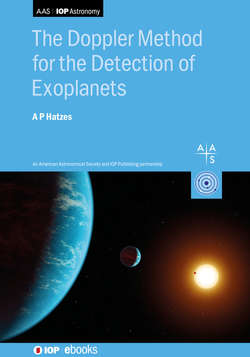Читать книгу The Doppler Method for the Detection of Exoplanets - Professor Artie Hatzes - Страница 5
На сайте Литреса книга снята с продажи.
Contents
ОглавлениеPreface
Acknowledgments
Author biography
1 Introduction
1.1 The Dawn of Doppler Measurements
1.2 Early Work on Stellar Radial Velocity Measurements
1.3 Toward Precise Stellar Radial Velocity Measurements
1.4 The Early Hints of Exoplanets
1.5 The 51 Peg Revolution
1.6 The Doppler Method
References
2 The Instruments for Doppler Measurements
2.1 Echelle Spectrographs
2.1.1 Gratings
2.1.2 Cross-dispersers
2.1.3 Dispersion and Spectral Resolution
2.1.4 The Blaze Function
2.1.5 Scattered Light
2.2 Fourier Transform Spectrometers
2.3 Charge-coupled Device Detectors
2.3.1 The Structure and Operation of a CCD
2.3.2 Quantum Efficiency
2.3.3 Bias Level
2.3.4 Gain
2.3.5 Readout Noise and Dark Current
2.3.6 Charge Transfer Efficiency
2.3.7 Linearity
2.3.8 Flat Fielding
2.3.9 Saturation and Blooming
2.3.10 Fringing
2.3.11 Persistence
References
3 Factors Influencing the Radial Velocity Measurement
3.1 Instrumental Characteristics
3.1.1 Wavelength Coverage
3.1.2 Signal-to-noise Ratio
3.1.3 Resolving Power
3.2 Stellar Characteristics
3.2.1 Stellar Rotational Velocity
3.2.2 Spectral Line Strength
3.2.3 Number Density of Spectral Lines
3.3 RV Precision across Spectral Types
3.3.1 Radial Velocities of High-mass Stars
3.3.2 Radial Velocities of Low-mass Stars
References
4 Simultaneous Wavelength Calibration
4.1 Instrumental Shifts
4.2 Hollow Cathode Lamps
4.2.1 Th–Ar
4.2.2 HCL in the Infrared
4.3 The Telluric Method
4.4 Gas Absorption Cells
4.4.1 The Hydrogen Fluoride Cell
4.4.2 The Iodine Absorption Cell
4.4.3 Absorption Cells at Infrared Wavelengths
4.5 Laser Frequency Combs
4.6 Fabry–Pérot Etalons
4.7 The RV Precision of Modern Spectrographs
References
5 Calculating the Doppler Shifts: The Cross-correlation Method
5.1 Mathematical Formalism
5.2 Choice of Template
5.2.1 Standard Stars
5.2.2 Synthetic Masks
5.2.3 Self-templates
5.2.4 Mismatched Template and Stellar Spectra
5.3 CCF Detection of Spectroscopic Binaries
5.4 Fahlman–Glaspey Shift Detection
References
6 The Iodine Cell Method
6.1 The Instrumental Profile
6.2 Modeling the IP with the Iodine Cell Method
6.3 Influence of Changes in the IP
6.4 Ingredients for the Iodine Cell Method
6.4.1 The Fiducial
6.4.2 The Template
6.5 Calculation of the Doppler Shift
6.6 Construction of an Iodine Cell
6.7 Closing Remarks
References
7 Frequency Analysis of Time Series Data
7.1 Introduction
7.2 The Discrete Fourier Transform
7.2.1 Convolution
7.2.2 Visualizing Fourier Transforms
7.3 The Lomb–Scargle Periodogram
7.4 The Generalized Lomb–Scargle Periodogram
7.5 The Bayesian Generalized Lomb–Scargle Periodogram
7.6 Comparison of the Types of Periodograms
7.7 The Spectral Window
7.8 The Nyquist Frequency and Aliasing
7.9 Frequency Resolution
7.10 Assessing the Statistical Significance
7.10.1 Using the Lomb–Scargle Periodogram
7.10.2 Using the Fourier Amplitude Spectrum
7.10.3 Bootstrap Randomization
7.11 Finding Multiperiodic Signals in Your Data
7.12 Required Number of Observations
7.13 Frequency versus Period
References
8 Keplerian Orbits
8.1 Orbital Parameters
8.2 Describing the Orbital Motion
8.3 The Radial Velocity Curve
8.4 The Mass Function
8.5 Mean Orbital Inclination
8.6 Eccentric Orbits
8.6.1 Observing Biases Caused by Eccentric Orbits
8.6.2 Eccentric Orbits in the Fourier Domain
8.6.3 Keplerian Periodograms
8.7 Calculating Keplerian Orbits
8.7.1 Transiting Planets
8.8 Dynamical Effects
8.8.1 Dynamical Stability
8.8.2 Planet Interactions
8.9 Barycentric Corrections
References
9 Avoiding False Planets: Rotational Modulation
9.1 Introduction
9.2 Spots
9.3 Plage and Faculae
9.4 Granulation and Convective Blueshift
9.4.1 The Sun Viewed as a Star
9.4.2 Velocity Spots
9.5 Testing for Rotational Modulation
9.5.1 Determining the Rotation Period of the Star
9.5.2 Evolution of Statistical Significance
9.5.3 Amplitude Variations
References
10 Avoiding False Planets: Indicators of Stellar Activity
10.1 Activity Indicators
10.1.1 Ca II H & K
10.1.2 Hα
10.1.3 Na D
10.1.4 TiO Bands
10.1.5 Hydroxyl 1.563 μm Absorption
10.2 Line Depth Ratios
10.3 Spectral Line Shapes
10.3.1 Line Bisectors
10.3.2 Line Widths
10.4 Chromatic RV Variations
10.5 Use of Individual Lines
10.5.1 Radial Velocities
10.5.2 Convective Blueshifts versus Line Strength
10.6 Radial Velocity Jitter
10.6.1 RV Jitter and Orbit Fitting
10.6.2 Sources of Jitter
10.6.3 Stellar Oscillations
10.6.4 Activity Jitter
10.7 Activity Cycles
10.8 Concluding Remarks
References
11 Dealing with Stellar Activity
11.1 Fourier Filtering
11.1.1 The Pitfalls of Prewhitening
11.2 High Pass Filtering
11.2.1 Local Trend Fitting
11.2.2 Floating Chunk Offset
11.3 Gaussian Processes
11.4 A Short Comparison of Filtering Methods
11.5 The RV Challenge
11.6 Toward Earth Analogs
References
12 Contributions to the Error Budget
12.1 Guiding Errors
12.2 Changes in the Instrumental Setup
12.3 Detector Errors
12.3.1 Electronic Noise Pickup
12.3.2 CCD Inhomogeneities and Discontinuities
12.3.3 Charge Transfer Effects
12.4 Errors in the Barycentric Correction
12.4.1 Inaccurate Time of Observations
12.4.2 Inaccurate Telescope Coordinates
12.4.3 Inaccurate Stellar Positions
12.4.4 Differential Barycentric Motion
12.5 The Secular Acceleration
12.6 Telluric Line Contamination
12.7 Moonlight Contamination
References
13 The Rossiter–McLaughlin Effect
13.1 Introduction
13.2 Origin of the Rossiter–McLaughlin Effect
13.3 The Rossiter–McLaughlin Effect in Exoplanets
13.3.1 The Radial Velocity Amplitude
13.3.2 The Spin–Orbit Alignment
13.4 Spin Axis of the Star
References
